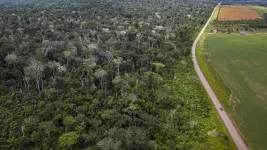Patient case strongly suggests link between COVID-19 vaccine and Bell's palsy
The patient experienced facial palsy after each dose of the Pfizer-BioNTech vaccine
2021-07-20
(Press-News.org) The case of a patient who experienced two facial palsies - one after the first and another after the second dose of the Pfizer-BioNTech COVID-19 vaccine - strongly suggests that Bell's palsy (facial nerve palsy of unknown cause) is linked to the Pfizer-BioNTech vaccine, doctors write in the journal BMJ Case Reports.
They describe the first case to be reported in the medical literature of two separate unilateral facial nerve palsies, where muscles on one side of the face become weak or paralysed, occurring shortly after each dose of a COVID-19 vaccine.
"The occurrence of the episodes immediately after each vaccine dose strongly suggests that the Bell's palsy was attributed to the Pfizer-BioNTech vaccine, although a causal relationship cannot be established," the authors say.
Single episodes of unilateral facial nerve palsies were reported in the initial clinical trials of the three major COVID-19 vaccines approved for use in the UK (Pfizer-BioNTech, Moderna and Oxford/Astra Zeneca), and there have been subsequent case reports.
In phase 3 trials, four cases of facial palsy of unknown cause (Bell's palsy) were reported in volunteers who received the Pfizer-BioNTech mRNA vaccine compared with none in those who received the placebo vaccine, and three cases were reported in volunteers who received the Moderna mRNA vaccine compared with one in the placebo group. Three cases of facial nerve palsy were also reported in volunteers who received the Oxford/AstraZeneca vaccine during clinical trials, and there were three cases in volunteers who received the placebo vaccine.
This case report describes a 61-year-old Caucasian man with no previous history of facial nerve palsy who experienced an episode of Bell's palsy on the right side of his face five hours after receiving his first dose of the Pfizer-BioNTech vaccine, and a more severe episode of Bell's palsy on the left side of his face two days after receiving the second dose.
The patient had a high BMI, high blood pressure, high cholesterol and type 2 diabetes. Both doses of the vaccine were administered to the left arm.
The patient attended the emergency department after the first episode, unable to close his left eye properly or move the left side of his forehead and was diagnosed with Bell's palsy. Routine bloods and a CT head scan showed nothing of concern and he was discharged with a course of steroids, and the facial nerve palsy completely resolved.
The patient received the second dose of the Pfizer-BioNTech vaccine six weeks after the first, and developed a more severe left-sided facial nerve palsy two days later. The symptoms included dribbling, difficulty swallowing and inability to fully close his left eye. He went to the emergency department, where he was again prescribed a course of steroids. He was also referred to the emergency ENT (Ear Nose and Throat) clinic, which continued the steroids and referred him to ophthalmology.
The authors report that his symptoms have greatly improved and the patient is almost back to normal. "The patient has been advised to discuss future mRNA vaccines with the GP on a case-by-case basis, taking into account risk versus benefit of having each vaccine," they say.
Bell's palsy is believed to be related to facial nerve inflammation and swelling due to build up of fluid (oedema) caused by a virus. In 2004 the inactivated intranasal influenza vaccine was shown to significantly increase the risk of Bell's palsy and was discontinued. Increased incidence of Bell's palsy has also been seen following administration of other influenza and meningococcal vaccines, although a causal link has not been established.
Although most cases of Bell's palsy spontaneously recover with time, the symptoms can cause significant temporary disability, affecting facial expression and ability to eat and drink. Risk factors include diabetes, obesity, hypertension, pregnancy, pre-eclampsia and upper respiratory disease.
INFORMATION:
Externally peer reviewed? Yes
Evidence type: Single case report
Subjects: People
ELSE PRESS RELEASES FROM THIS DATE:
2021-07-20
Although lockdowns are undoubtedly associated with health harms, their impact on health is unlikely to be worse than the impact of the COVID-19 pandemic itself, concludes a review published in the online journal BMJ Global Health.
During the COVID-19 pandemic, there has been an ongoing debate around whether the benefits of government "lockdowns"- either stay-at-home orders or interventions restricting movement - in reducing infections are outweighed by the negative impacts on the economy, social structure, education, and mental and physical health. In a nutshell, whether "the cure is worse than the disease."
In this narrative review, an international team of doctors examine the ...
2021-07-20
One in eight children have mental disorders that cause symptoms and impairment and therefore require treatment, but even in high-income countries most of these children will not gain access to services to treat them, reports a study published in the journal Evidence-Based Mental Health.
Mental disorders that start in childhood and adolescence can significantly interfere with wellbeing and development.
Despite the social and economic implications of not addressing these disorders, including long-term healthcare costs, justice system costs and the loss of human potential, mental health service provision for children continues to lag behind provision of services for physical ...
2021-07-20
Below please find summaries of new articles that will be published in the next issue of Annals of Internal Medicine. The summaries are not intended to substitute for the full articles as a source of information. This information is under strict embargo and by taking it into possession, media representatives are committing to the terms of the embargo not only on their own behalf, but also on behalf of the organization they represent.
1. Rapid screening, face masks may prevent SARS-CoV-2 transmission at indoor mass-gathering events
Abstract: https://www.acpjournals.org/doi/10.7326/M21-2278
URL goes live when the embargo lifts
An observational study in Barcelona, Spain found that implementation of same-day rapid screening, use of face masks, and improved ventilation was ...
2021-07-19
Although people in early 2020 hoarded toilet paper, washed their hands incessantly, and wouldn't leave home, 11 months later the public pushed the envelope on COVID-19 safety precautions and ignored warnings as time went on, a new University of California, Davis, study suggests.
Researchers in the Department of Communication examined people's reactions and expressions of anxiety about news articles on Twitter. Additionally, they investigated reactions to fear-inducing health news over time, despite the steadily rising COVID-19 death toll, said Hannah Stevens, a doctoral student in communication and lead author of the paper.
The paper, "Desensitization to Fear-Inducting COVID-19 Health News on Twitter: Observational Study," ...
2021-07-19
Two common practices in the U.S. restaurant industry -- service with a smile and tipping -- contribute to a culture of sexual harassment, according to new research from the University of Notre Dame.
"A perfect storm: Customer sexual harassment as a joint function of financial dependence and emotional labor" was recently published in the Journal of Applied Psychology from Timothy Kundro, assistant professor of management and organization at Notre Dame's Mendoza College of Business.
In the study, co-authored by Alicia Grandey and Vanessa Burke from Penn State University and Gordon Sayre from Emlyon Business School in France, more than 66 percent of restaurant employees reported facing some form of sexual harassment in the past six months.
Previous ...
2021-07-19
By uprooting carbon trapped in soil, wild pigs are releasing around 4.9 million metric tonnes of carbon dioxide annually across the globe, the equivalent of 1.1 million cars.
An international team led by researchers from The University of Queensland and The University of Canterbury have used predictive population models, coupled with advanced mapping techniques to pinpoint the climate damage wild pigs are causing across five continents.
UQ's Dr Christopher O'Bryan said the globe's ever-expanding population of feral pigs could be a significant threat to the climate.
"Wild pigs are just like tractors ploughing through fields, turning over soil to find food," Dr O'Bryan said.
"When soils are ...
2021-07-19
Research conducted at the Sharon Eccles Steele Center for Translational Medicine (SCTM) at the University of Utah's John A. Moran Eye Center explains why people carrying a block of genetic variants strongly associated with the development of age-related macular degeneration (AMD) may develop the disease and identifies a potential therapeutic pathway for slowing or even reversing disease progression.
AMD is a major cause of irreversible blindness worldwide and the leading cause of blindness for Americans aged 55 and over. Following more than 15 years of research that has employed an extensive repository of donated human ocular ...
2021-07-19
A new approach to analyse satellite measurements of Earth's cloud cover reveals that clouds are very likely to enhance global heating.
The research, by scientists at Imperial College London and the University of East Anglia, is the strongest evidence yet that clouds will amplify global heating over the long term, further exacerbating climate change.
The results, published today in Proceedings of the National Academy of Sciences, also suggest that at double atmospheric carbon dioxide (CO2) concentrations above pre-industrial levels, the climate is unlikely to warm below 2°C, and is more likely on average to warm more than 3°C.
Pre-industrial CO2 levels were around 280 ppm (parts per million), ...
2021-07-19
Throughout history, people of different cultures and stages of evolution have found ways to adapt, with varying success, to the gradual warming of the environment they live in. But can the past inform the future, now that climate change is happening faster than ever before?
Yes, say an international team of anthropologists, geographers and earth scientists in Canada, the U.S. and France led by Université de Montréal anthropologist Ariane Burke.
In a paper published today in the Proceedings of the National Academy of Sciences, Professor Burke and her colleagues ...
2021-07-19
A major drought and forest fires in the Amazon rainforest killed billions of trees and plants and turned one of the world's largest carbon sinks into one of its biggest polluters.
Triggered by the 2015-16 El Niño, extreme drought and associated mega-wildfires caused the death of around 2.5 billion trees and plants and emitted 495 million tonnes of CO2 from an area that makes up just 1.2 per cent of the entire Brazilian Amazon rainforest, and 1 per cent of the whole biome.
The stark findings, discovered by an international team of scientists working for more than eight years on a long-term study in the Amazon before, during and after the El Niño, have significant implications for global efforts to control the atmospheric ...
LAST 30 PRESS RELEASES:
[Press-News.org] Patient case strongly suggests link between COVID-19 vaccine and Bell's palsy
The patient experienced facial palsy after each dose of the Pfizer-BioNTech vaccine


